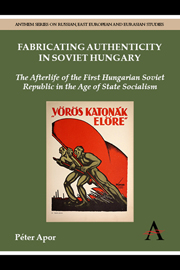 Fabricating Authenticity in Soviet Hungary
Fabricating Authenticity in Soviet Hungary Book contents
- Frontmatter
- Contents
- Acknowledgements
- List of Illustrations
- List of Abbreviations
- Introduction
- Chapter 1 Prefiguration: The First Hungarian Soviet Republic and the Rákosi Dictatorship before 1956
- Chapter 2 Resurrection: The Emergence of 1919 and the Counterrevolution after 1956
- Chapter 3 Lives: 1919 in the Postwar Trials of War Criminals
- Chapter 4 Funeral: The Birth of the Pantheon of the Labour Movement in Budapest
- Chapter 5 Narration: History, Fiction and Proof in the Representation of the First Hungarian Soviet Republic, 1959–65
- Epilogue The Agitators and the Armoured Train
- Index
Chapter 4 - Funeral: The Birth of the Pantheon of the Labour Movement in Budapest
Published online by Cambridge University Press: 05 April 2014
- Frontmatter
- Contents
- Acknowledgements
- List of Illustrations
- List of Abbreviations
- Introduction
- Chapter 1 Prefiguration: The First Hungarian Soviet Republic and the Rákosi Dictatorship before 1956
- Chapter 2 Resurrection: The Emergence of 1919 and the Counterrevolution after 1956
- Chapter 3 Lives: 1919 in the Postwar Trials of War Criminals
- Chapter 4 Funeral: The Birth of the Pantheon of the Labour Movement in Budapest
- Chapter 5 Narration: History, Fiction and Proof in the Representation of the First Hungarian Soviet Republic, 1959–65
- Epilogue The Agitators and the Armoured Train
- Index
Summary
For many decades, the Pantheon of the Labour Movement situated in the Kerepesi Cemetery of Budapest was regarded by the then ruling Hungarian Communist Party as one of its principal commemorative constructions. Nowadays, the building stands abandoned. On the one hand, while the era of the Communist politics of history seems to be over forever, this is precisely why the monument's megalomaniac attempt to reinterpret the national past may seem familiar to us. On the other hand, this monumentality is exactly what renders the story of the pantheon distant and unfamiliar: what could be the origins of this obsession towards the dead?
The memorial, as we know it today, gained its form in 1959 with the inauguration of its most significant and architecturally monumental part: the Mausoleum of the Labour Movement. The mausoleum itself consists of different elements. Its central building is the mausoleum proper, containing urns of cremated corpses; it is completed by six pillars designed to commemorate those who were buried outside the cemetery. A row of honorary graves, considered to be the most prestigious burial site for those who were not cremated, is situated in front of the central building. A plot by the side of the mausoleum was opened to receive the remnants of less significant persons, while four other plots and a so-called ‘heroes’ plot' were counted among the parts of the Pantheon of the Labour Movement as well.
- Type
- Chapter
- Information
- Fabricating Authenticity in Soviet HungaryThe Afterlife of the First Hungarian Soviet Republic in the Age of State Socialism, pp. 125 - 164Publisher: Anthem PressPrint publication year: 2014


